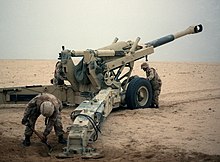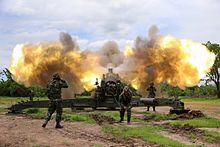
Nuclear artillery is a subset of limited-yield tactical nuclear weapons, in particular those weapons that are launched from the ground at battlefield targets. Nuclear artillery is commonly associated with shells delivered by a cannon, but in a technical sense short-range artillery rockets or tactical ballistic missiles are also included.
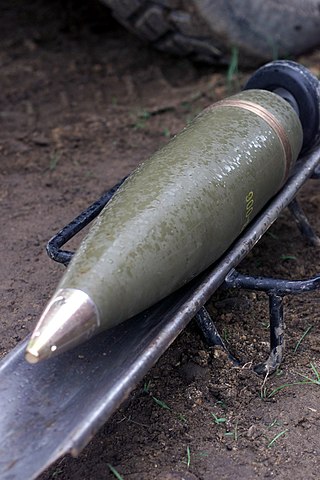
The M107 is a 155 mm high explosive projectile used by many countries. It is a bursting round with fragmentation and blast effects. It used to be the standard 155 mm high explosive projectile for howitzers of the US Army and US Marine Corps, but is being superseded in the US military by the M795.

The 2S1 Gvozdika is a Soviet self-propelled howitzer introduced in 1972 and in service in Russia and other countries as of 2023. It is based on the MT-LBu multi-purpose chassis, mounting a 122 mm 2A18 howitzer. "2S1" is its GRAU designation. An alternative Russian designation is SAU-122, but in the Russian Army it is commonly known as Gvozdika. The 2S1 is fully amphibious with very little preparation, and once afloat is propelled by its tracks. A variety of track widths are available to allow the 2S1 to operate in snow or swamp conditions. It is NBC protected and has infrared night-vision capability.

The M777 howitzer is a towed 155 mm artillery piece in the howitzer class. It is used by the ground forces of Australia, Canada, Colombia, India, Saudi Arabia, Ukraine, and the United States. It was first used in combat during the War in Afghanistan.

The M114 is a towed howitzer developed and used by the United States Army. It was first produced in 1942 as a medium artillery piece under the designation of 155 mm Howitzer M1. It saw service with the US Army during World War II, the Korean War, and the Vietnam War, before being replaced by the M198 howitzer.

The M119 howitzer is a lightweight 105 mm howitzer, used by the United States Army. It is the American licensed version of the British L119 light gun. The M119 is typically towed by the M1097 or M1152 High Mobility Multi-Purpose Wheeled Vehicle (HMMWV), and can be easily airlifted by helicopter, or airdropped by parachute.

A dual-purpose improved conventional munition (DPICM) is an artillery or surface-to-surface missile warhead designed to burst into submunitions at an optimum altitude and distance from the desired target for dense area coverage. The submunitions use both shaped charges for the anti-armor role, and fragmentation for the antipersonnel role, hence the nomenclature "dual-purpose". Some submunitions may be designed for delayed reaction or mobility denial (mines). The air-to-surface variety of this kind of munition is better known as a cluster bomb. They are banned by more than 100 countries under the Convention on Cluster Munitions.

The L118 light gun is a 105 mm towed howitzer. It was originally designed and produced in the United Kingdom for the British Army in the 1970s. It has since been widely exported. The L119 and the United States Army's M119 are variants that use a different type of ammunition.

The M712 Copperhead is a 155 mm caliber cannon-launched guided projectile. It is a fin-stabilized, terminally laser guided, explosive shell intended to engage hard point targets such as tanks, self-propelled howitzers or other high-value targets. It may be fired from different artillery pieces, such as the M114, M109, M198, M777 and CAESAR howitzers. The projectile has a minimum range of 3 km (1.9 mi) and a maximum range of 16 km (9.9 mi).

The M982 Excalibur is a 155 mm extended-range guided artillery shell developed in a collaborative effort between the U.S. Army Research Laboratory (ARL) and the United States Army Armament Research, Development and Engineering Center (ARDEC). The Excalibur was developed and/or manufactured by prime contractor Raytheon Missiles & Defense, BAE Systems AB and other subs and primes in multiple capacities such as Camber Corporation and Huntington Ingalls Industries. It is a GPS and inertial-guided munition capable of being used in close support situations within 75–150 meters (250–490 ft) of friendly troops or in situations where targets might be prohibitively close to civilians to attack with conventional unguided artillery fire. In 2015, the United States planned to procure 7,474 rounds with a FY 2015 total program cost of US$1.9341 billion at an average cost of US$258,777 per unit. By 2016, unit costs were reduced to US$68,000 per round. Versions that add laser-guidance capability and are designed to be fired from naval guns began testing in 2015. By October 2018, over 1,400 rounds had been fired in combat.

The SO-152, usually known by its GRAU designation 2S3, is a Soviet 152.4 mm self-propelled gun developed in 1968, as a response to the American 155 mm M109 howitzer. Development began in 1967, according to the Resolution of the Council of Ministers of the Soviet Union from July 4, 1967. In 1968, the SO-152 was completed and in 1971 entered service. The fighting vehicle also received the added designation Akatsiya (Акация), which is Russian for Acacia.
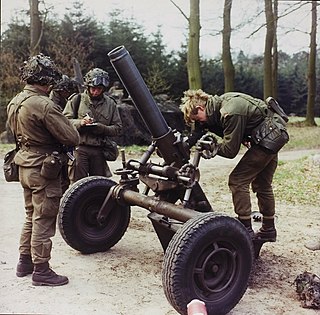
The MO-120 RT or MO-120-RT is a French heavy mortar. The RT in the designator stands for rayé, tracté, which means rifled, towed. The MO-120-RT is currently used by the French Army, and has also been exported to more than 24 foreign countries or in some cases, produced under licence. It is issued to artillery units, where it complements artillery guns and systems; although infantry units operate it in some countries.
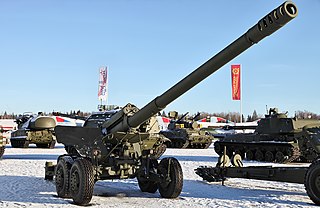
The 2A36 Giatsint-B is a Soviet/Russian towed 152 mm field gun which entered service in 1975. The 2A36 is designed to suppress and destroy enemy manpower and equipment. It is also suitable for counter-battery fire. The gun can be used in various weather conditions and has been tested in temperatures ranging from −50 °C to 50 °C.

The 152 mm gun-howitzer M1955, also known as the D-20, is a manually loaded, towed 152 mm gun-howitzer artillery piece, manufactured in the Soviet Union during the 1950s. It was first observed by the West in 1955, at which time it was designated the M1955. Its GRAU index is 52-P-546.

The 2K25 Krasnopol is a Soviet 152/155 mm cannon-launched, fin-stabilized, base bleed-assisted, semi-automatic laser-guided artillery weapon system. It automatically 'homes' on a point illuminated by a laser designator, typically operated by a drone or ground-based artillery observer. Krasnopol projectiles are fired mainly from Soviet self-propelled howitzers such as the 2S3 Akatsiya and 2S19 Msta-S and are intended to engage small ground targets such as tanks, other direct fire weapons, strong-points, or other significant point targets visible to the observer. It can be used against both stationary and moving targets.

155 mm is a NATO-standard artillery shell caliber that is used in many field guns, howitzers, and gun-howitzers. It is defined in AOP-29 part 1 with reference to STANAG 4425.
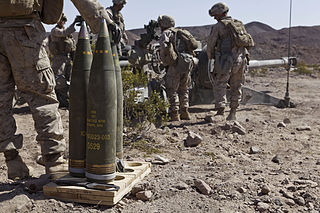
The M795 155 mm projectile is the US Army and US Marine Corps' standard 155 mm High Explosive (HE) projectile for howitzers. It is a bursting round with fragmentation and blast effects.

The M549 is a high-explosive rocket-assisted (HERA) 155 mm howitzer round developed for use by the US military in order to add additional range to standard howitzers, with a maximum range 30.1 km (18.7 mi) from a M198 howitzer. The projectile has two distinctive pre-assembled components—the high explosive (HE) warhead and the rocket motor, making it a form of rocket-assisted projectile. The warhead is fabricated from high fragmentation steel for increased effectiveness in terms of damage caused to target and contains a bulk-filled explosive.

The M1128 "Insensitive Munition High Explosive Base Burn Projectile" is a 155 mm boosted artillery round designed to achieve a maximum range of 30–40 km. It is used for fragmentation and blast effect against personnel and/or materiel. The development of this round follows testing of boosted M795-series test projectiles. The M1128 is not yet in production, but the first successful test firings have already taken place.

The Remote Anti-Armor Mine System (RAAMS) are two types of 155mm howitzer projectiles containing nine anti-tank mines each. They were developed for the United States Army around 1980.
